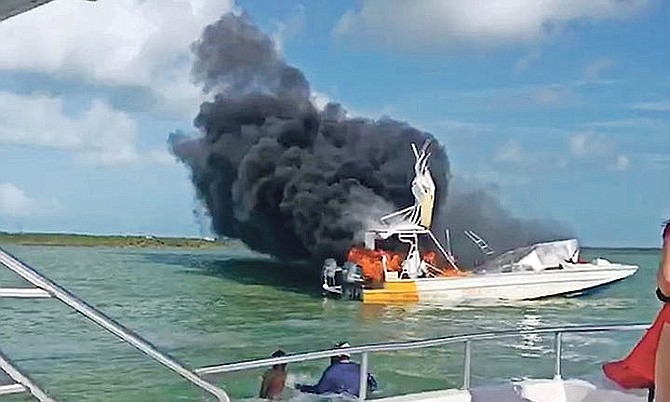By PAVEL BAILEY
Tribune Court Reporter
pbailey@tribunemedia.net
THE Exuma tour boat that exploded in 2018 leaving an American woman dead and several others injured was made of poor-quality aluminium and had no insulation in its wiring which likely caused the fire after it came in contact with fuel, a police officer testified yesterday.
Calling the explosion “disastrous”, Inspector Dwayne Lewis outlined several issues with the vessel that could have contributed to the deadly tragedy.
Inspector Lewis and a medical examiner gave testimony yesterday in the Supreme Court during the trial of two men charged in connection with the 2018 Exuma boat explosion.
Clayton Patterson-Smith and Roderick Watson, represented by Murrio Ducille, are on trial before Justice Jeanine Weech-Gomez on charges of manslaughter by negligence and causing harm by negligence.
It is alleged that on June 30, 2018 the two, due to negligence, were responsible for the boat explosion that caused the death of 39-year-old Maleka Jackson. Four other passengers aboard the recreational vessel at the time of the incident were also injured.
During his testimony, Insp Lewis told the court that in his inspection of the vessel that he saw no evidence of a bilge pump or a fuel gauge.
The officer also stated that the aluminum used to make the vessel was not of a high quality as it should not have disintegrated to the point that it did as a result of the fire if it were of a better quality. He said the top deck of the vessel was completely disintegrated in the fire and that a higher quality metal would have mitigated damage to passengers.
In reference to the overall construction of the vessel, the inspector said that it was not in keeping with industry standards.
After stating that no insulation in the boat’s wiring was a probable cause for the fire after it came in contact with the fuel, he called it negligent for the fuel filters to be so close to the electrical machinery.
When asked to classify the size of the explosion by the prosecutor for the Crown, Raquel Whymms, Inspector Lewis said it was “disastrous”. He further said that evidence suggests that due to the extent of damage, the fire likely started on the starboard side near the bow.
The officer said that there was no registration number attached to the vessel nor was there any indication of fire extinguishers or lifejackets being aboard the vessel during the incident.
During his testimony, Inspector Lewis identified one of the accused in court as the boat owner.
Earlier yesterday, Dr Karen Sands, a pathologist at PMH, discussed her involvement in the case. Dr Sands told the court that on July 3, 2018 she conducted the autopsy on Ms Jackson for which she listed her cause of death as complications of blunt force trauma to the lower extremities.
After the death certificate signed by Dr Sands was entered into evidence, she went into detail of her findings in the autopsy report. She said the victim suffered from multiple contusions and abrasions to her legs as well as having the tibia and fibula in her right leg fractured with tissue necrosis, as well as the bones in her left leg being broken.
Dr Sands said that Ms Jackson’s left leg was almost completely severed and held on by skin as a result of a traumatic near amputation in the boat tragedy.
The prosecution announced yesterday that it had closed its case.
The trial will continue today.





Commenting has been disabled for this item.